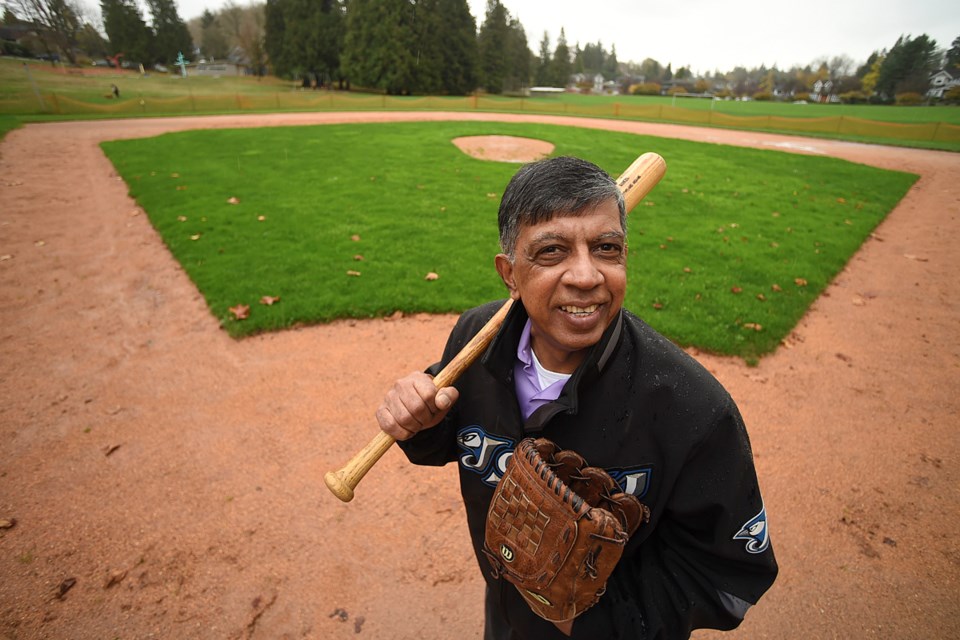Fans of the Chicago Cubs may have thought something divine intervened to end a 108-year World Series drought. Of course, baseball fans are known for an almost religious devotion to their team, as well as a host of superstitions.
A new book by a Vancouver writer contends that there is, indeed, something inherent in baseball that hearkens back to our most primal religious, ritualistic and existential impulses.
In The Prehistories of Baseball, Dr. Seelochan Beharry finds Christian, Buddhist, Hindu and other religious influences in what has come to be known as baseball. Even more fundamentally, he argues, the three basic actions in baseball are central to humanity’s very existence.
“The fundamental skills in this game of throwing, hitting and running are the same ones that facilitated human survival on our rise to the top of the food chain and dominance on the planet,” he writes.
Because rock throwing was the primary means of both self-defence and hunting for our primate ancestors, excellent throwers became great warriors and heroes of legend. Practising throwing — and competition for excellence in this primal act — was a form of training for battle, as well as a bonding ritual between parents and children and among peers. With opposable thumbs came better tools and more aptly aimed weapons, such as a club that could hurl a rock further. Reducing the circumference of the club’s handle and increasing the size of its barrel maximizes the impact, whether the item in question is Fred Flintstone’s club or Kris Bryant’s bat.
“Art and games often imitate and reflect life,” writes Beharry.
Beharry draws together ancient traditions to present a highly plausible case for a theory that is ultimately unknowable, but the parallels between baseball and certain activities of the past are remarkable.
There is speculation that ancient Celts made sacrifices to three gods on three specifically marked altars in a clearing, sort of resembling the three bases where opposing baseball players are “sacrificed.”
Burial mounds are an apparently universal human phenomenon and Celts are believed to have reenacted heroic battles of the dead warrior on their burial mounds. In plenty of cultures, a central elevated meeting area was the locus of sacred activity, just as the pitcher’s mound is the central focus of the game.
The diamond also suggests ancient geometrical fascinations. Buddhists and Hindus had mandalas, Europeans and Mesoamericans, among others, used concentric circles, squares and rectangles for ritual purposes.
Life and death is acted out on this mock battlefield, too, with the ins (hitters) trying to invade the territory of the outs (fielders), then trading places in a passage between “worlds” that reflects a common theological view of both death and life as transitory. A hitter’s progress is like life, Beharry writes, involving a prolonged journey that nevertheless ends up just where it began.
Tree or stone worshipers in ancient times circled objects in supplication. A Maypole is a ritualized example of this. Similar to this, Beharry notes, is the circumambulation in baseball — running around bases.
All of this circumstantial evidence makes a decent case that ancient peoples, like the Celtic pagans, ritualized sacred activities in ways that at least remotely resembled what we might recognize as baseball.
When Christianity came, pagan games that encouraged drinking, fighting and gambling were discouraged. Christianity repressed many pagan rituals, which were then transformed into recreational activities sanitized of religious overtones or, alternatively, usurped by Christians. The three bases of pagan sacrifice could be reinterpreted as the Christian trinity.
Beharry, whose book came out this year, is a biochemist, not a theologian or historian of ancient ritual. But he is also an avid baseball fan and a long-time coach for the Marpole League and Vancouver Community Baseball.
“It’s always had a kind of cathedral effect to me,” Beharry says of the game. He had also heard talk that baseball had religious antecedents. Growing up in British Guiana, now Guyana, Beharry’s parents were Hindu but he went to a Presbyterian church because that’s what his friends did and his parents didn’t mind. From this background, he began exploring cultural indictors in the game.
There is, of course, plenty of superstition in baseball, not least of which is the Curse of the Billy Goat attached to the Cubs inability to win a World Series. And for those given to numerology, nine, like the number of players and innings, and three, like the bases and outs, are sacred or superstitious numbers in many Indo-European cultures. Today’s players often wear chains of metal, ostensibly for unproven health benefits, parallel to the unprovable benefits of amulets and charms worn by our ancestors.
Even spitting — frowned upon elsewhere and gross everywhere — is still acceptable in the dugout. In ancient times, and even more recent times, spitting has been seen as a way of warding off curses and the evil eye.
The great baseball stadiums of today have some commonalities with both the cathedrals and the battlefields of the past, intended to inspire awe and intimidation. Busts and uniforms of late greats, trophies and banners marking past victories replace the severed heads of respected opponents. Rapturous fan participation and devotion resemble animated religious services.
The evidence laid out in his book is powerful and very entertaining, though Beharry acknowledges he can’t be certain of how direct the line is between ancient ritual and the contemporary game of baseball.
“Though the true meanings of early rituals may forever elude us, their vestiges live on in a game we have come to view as our own.”
PacificSpiritPJ@gmail.com



